Swedish dinners: Stuvad lake
Swedish dinners: Stuvad lake
-
-
-
-
-
Swedish dinners: Stuvad lake
-
Post #1 - February 27th, 2008, 2:43 amWinter is the best time of the year to eat "lake", or burbot. Burbot are related to cod and live in the cold, dark, freshwater lakes of northern Sweden. They can, of course, be eaten year round. However, burbot spawn midwinter and therefore are full of roe between December and February.
Burbot isn’t very popular in Sweden anymore. I bought this fish at giveaway prices and the fishmonger seemed surprised that I’d want it. He seemed downright suspicious when he noticed my accent but quickly warmed up when I mentioned that burbot, due to its slimy coating (the slime insulates them) and general low status amongst fishermen, are also known as “lawyers” in the Northern U.S. He even offered to inspect his four burbots to find the one with the most roe. Alas*, it seems I was a few weeks late in my searches as none of the burbots he had contained any roe.
Back in its day, burbot was a pretty popular fish. Burbot can be caught by any number of means but one method was especially popular for generations of poorer Swedes. In midwinter, burbot swim from their deep lairs to spawn in shallow, shoreline waters. And, with the right conditions (i.e., clear, snow-free ice), burbot can be stunned by smaking the ice with a sledge. Apparently, one does not want to hammer through the ice but instead simply crack a “rose” in it. This stuns the burbot. One then may make a hole in the “rose” and retrieve the fish.
And, finally, there is one aspect of the burbot that makes it especially appropriate for survival food: its liver. Burbot liver is both huge (up to 10% of its body weight) and packed full of vitamin D.
To the pictures!
The burbot:
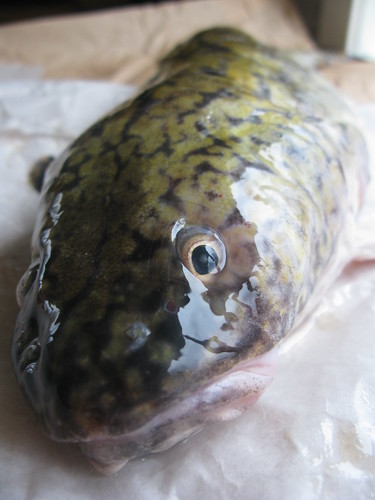

its liver:

Start by filleting the burbot and setting aside the fillets along with the liver (and roe, if your burbot hasn’t spawned yet).

With the scraps, bones and trimmings, make a quick stock. I simply rinsed the scraps in cold water and simmered them for about 45 minutes with ½ carrot, a little leek, 1 stalk of celery, a bay leaf and some thyme.
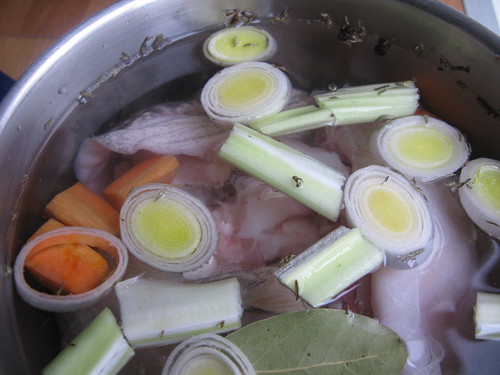
The ingredients for the final dish:

An onion, 1 stalk of celery, 1 small carrot, ½ of a leek, about 20 haricot verts (or, say 10 green beans), 1 tablespoon lemon juice, the burbot fillets and liver (about 1 ½ pounds – cod would make a fine substitute), one whole mace “flower” (maybe ½ tsp ground?), one bay leaf, ½ tablespoon instant-blending flour, ¾ cup white wine, 2 ½ cups of the burbot stock, 1 cup heavy cream or half & half, 2 egg yolks, about ½ cup broccoli florets (or peas or other green vegetable). Not pictured: 1 tablespoon white wine vinegar
Start by adding the wine, lemon juice, white wine vinegar, mace and bay leaf to the stock and bringing it to a simmer.

Add the fillets and the liver and simmer for 10-15 minutes.

While the fish is simmering, finely chop the onion, carrot, celery and leek and haricot verts:
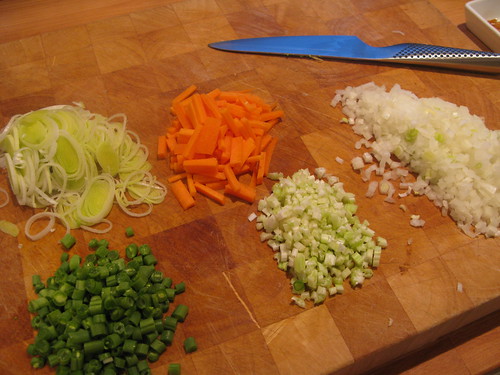
Remove the fish (keep warm) and strain the stock. Bring the stock back to a boil and reduce by half.
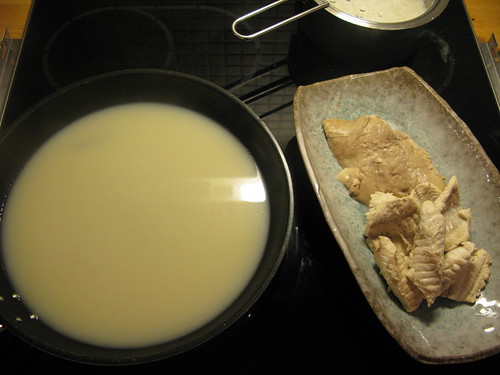
When reduced, add the cream…
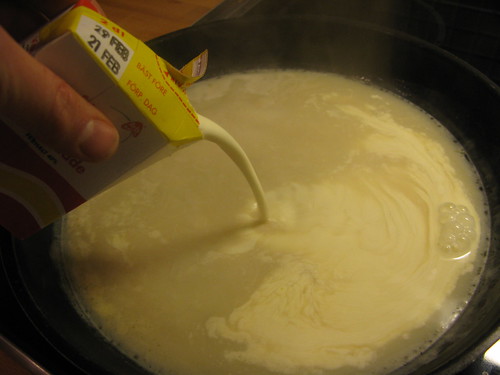
… and chopped vegetables:

Simmer for about 5 minutes.
Next, thicken the sauce. Start by adding the instant-blending flour:

Whisk in the flour and let the sauce thicken for a few minutes. Remove the sauce from the heat and add (while whisking) the two egg yolks. Taste and add salt and pepper as needed.
Place a serving of fish and liver on a plate, coat with sauce and vegetables, garnish and serve:

All in all, an excellent dish. The burbot (both the liver and the fillets) is mild tasting and, apart from its firmness, could easily be substituted with any type of cod or firm whitefish. The sauce was very rich and I’d probably recommend using half-and-half for anyone even a little sensitive to rich dishes. Finally, the mace makes for an interesting spice. I’m normally not wild about mace by itself (too much of it makes everything taste like ketchup to me) and was concerned after tasting the poaching liquid. However, once thickened and full of fresh-tasting vegetables, the mace flavor had kindly retreated to the background.
* I use “alas” lightly here. As I’ve mentioned elsewhere, I’ve become more and more squeamish about eating fish roe as report after report of collapsing fish stocks hits the newsstands.Last edited by Bridgestone on February 27th, 2008, 5:24 am, edited 2 times in total.
-
-
Post #2 - February 27th, 2008, 2:57 amFor the recipe index:
Stuvad lake/Burbot in cream sauce
1 2-pound, whole burbot (or 1 1/2 firm whitefish fillets)
ingredients to make fish stock from the fish trimmings (1/2 onion, celery stalk, small carrot, 1/2 tsp thyme and 1 bay leaf)
1 onion
1 stalk of celery
1 small carrot
½ of a leek
about 20 haricot verts (or 10 green beans)
1 tablespoon lemon juice
1 tablespoon white wine vinegar
one whole mace “flower” (½ tsp ground)
one bay leaf
½ tablespoon instant-blending flour
¾ cup white wine
2 ½ cups of the burbot stock
1 cup heavy cream or half & half
2 egg yolks
about ½ cup broccoli florets (or peas or other green vegetable)
If using a whole burbot, fillet and reserve liver and roe. Make approx. 3 cups of stock with the stock ingredients and all of the fish trimmings.
Bring stock to a boil after adding the white wine, the lemon juice, the vinegar, the mace and the bay leaf. Simmer the fish (fillets and liver/roe) for approx. 10-15 minutes. While the fish is is simmering, finely chop the onion, the celery, the carrot, the leek and the haricot verts. Remove fish (keep warm) and strain the poaching liquid. Reduce poaching liquid by 50%.
When reduced, add the cream to the poaching liquid followed by the chopped vegetables and the broccoli florets. Cook for 5 minutes.
Thicken the sauce by first adding the instant-blending flour (while whisking). Remove from heat and whisk in the egg yolks. Season to taste with salt and peppar.
Serve by adding the fish to the sauce and garnishing.
-
-
Post #3 - February 27th, 2008, 8:05 amGreat post and excellent mise en place! Thanks for the pictures and the recipe. If I can find some Pacific Cod, I know how I'll prepare it.
-
-
Post #4 - February 27th, 2008, 8:32 amThank you, FrankP!
-
-
Post #5 - February 27th, 2008, 10:13 pmGreat post - I'm a big fish enthusiast and always enjoy seeing new dishes from new fishes!
I seem to remember you introducing the sea wolf to me for the first time as well.
I have to say, the sea wolf and the burbot certainly give the monkfish a run for the money as one of the ugliest edible fish I've ever seen...

-
-
Post #6 - February 28th, 2008, 12:43 amThanks JayK!
Yeah, the burbot does get a pretty bad rap. I suppose that its eel-like tail doesn't exactly help in winning any popularity contests, either. However, I do find its colors and patterns beautiful. They range from darkish green and brown in some burbot to a mustard-yellow in others. Very frog-like but beautiful, at least in my eyes.
I'll be heading north of the Arctic Circle in about a week with the rest of my family on a skiing vacation. Last year, we were allowed to follow a group of local fisherman and watch while they pulled up their nets (from under the ice - a pretty interesting process). Apart from a few whitefish and arctic char, they mostly caught burbot. Burbots were dubbed "Eagle food" and simply thrown up on the ice for the birds to eat. If we get the chance to hang along this year, I'll certainly take some pictures for you, JayK.Last edited by Bridgestone on March 2nd, 2008, 7:39 am, edited 1 time in total.
-
-
Post #7 - March 1st, 2008, 8:31 pmBridgestone wrote:
The burbot:
This picture makes Hammond's and Cathy2's cicada exploits seem positively accessible! And I think we have the first nominee for next year's LTH calendar!Man : I can't understand how a poet like you can eat that stuff.
T. S. Eliot: Ah, but you're not a poet.

